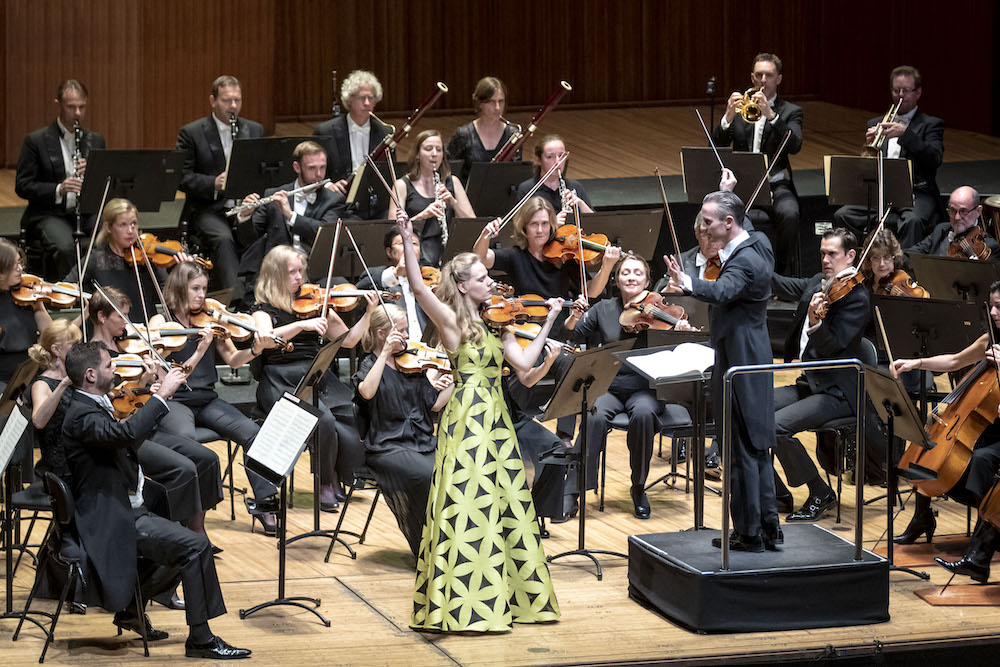When Franz Clement premiered Beethoven’s mammoth Violin Concerto in 1806, he inserted one of his own sonatas between the first and second movements, playing on one string with the violin held upside down. There was no such showboating in this performance by Dutch violinist Simone Lamsma, who delivered a reading of incredible subtlety and lyricism with the Sydney Symphony Orchestra and English conductor Alexander Shelley.
 Simone Lamsma, Alexander Shelley and the Sydney Symphony Orchestra. Photo © Daniela Testa
Simone Lamsma, Alexander Shelley and the Sydney Symphony Orchestra. Photo © Daniela Testa
Shelley’s opening – heralded by the five-note timpani figure that underpins the whole movement – was incredibly restrained, the conductor certainly not giving anything away too early. He set the mood perfectly, however, for Lamsma’s first entry, her fine-spun tone unfolding and swelling with gentle passion. This was a refined, organic performance: Lamsma’s pianissimos were whisper-quiet and spider-web delicate – but with underlying strength – her high register molten, her tone tearing silk in the double stopping of the cadenza.
Despite the virtuosity of Beethoven’s writing, Lamsma never put a foot out of place, her technique seemingly effortless and always understated, riding the deeper running currents of the music – no cheap thrills here, every climax was absolutely earned. Shelley proved a sensitive and intelligent collaborator on the podium, coaxing a warm, hushed sound from the strings in the opening of the Larghetto, ahead of Lamsma’s gossamer entry, the slow movement lingering exquisitely. The flourish that joins the second movement to the Rondo was elegantly dispatched, Lamsma finding a folky edge to her sound as she kicked off the final movement’s dance, rendered with sparkling virtuosity and a blistering cadenza, the fury of the finale the pay-off for the concerto’s slow-burn. The Largo from Bach’s Sonata No 3, BWV 1005, was an affecting encore in the aftermath.
The SSO’s horns and brass delivered Tchaikovsky’s dramatic ‘Fate’ fanfare – so named by the composer in the program he revealed (or invented) for his Fourth Symphony at the behest of his patron, Nadezhda von Meck – with clean, biting intensity. In fact, across the board, Shelley led an orchestra in incredible form. From the breathing room given to Matthew Wilkie’s baritone-like bassoon lines to a delightfully slinky clarinet solo from Francesco Celata, and the nimble energy of the lower strings, this was a performance of liquid, feline elegance. With the same subtlety he brought to the Beethoven, Shelley gave the music a rolling momentum that snowballed smoothly into climactic maelstroms. The audience was too stunned to applaud after the first movement’s shocking final bars, emitting something that sounded more like an awed exhalation. It was into that stunned atmosphere that Shefali Pryor’s rich-hued oboe solo emerged, Shelley shaping the second movement with frictionless crescendos and expansive string melodies. The full, vibrant pizzicati of the Scherzo ushered in wonderful wind moments (of which there were many in this concert), including hard flicks of flute from Joshua Batty and bright splashes of piccolo from Andrew Macleod (up from the Melbourne Symphony Orchestra). Shelley went all out on the riotous opening of the Finale, the festivities so bright and incandescent that their ultimate combustion into the ‘Fate’ theme seemed a logical inevitability, the movement almost foreshadowing Shostakovich with its manic edge.
The Beethoven and Tchaikovksy might be warhorses (which isn’t to say they aren’t also works of genius) but Lamsma, Shelley and the SSO made a powerful argument for saddling them up every now and again. A superlative performance.
The Sydney Symphony Orchestra’s Simone Lamsma Performs Beethoven’s Violin Concerto is at the Sydney Opera House until April 7












Comments
Log in to join the conversation.